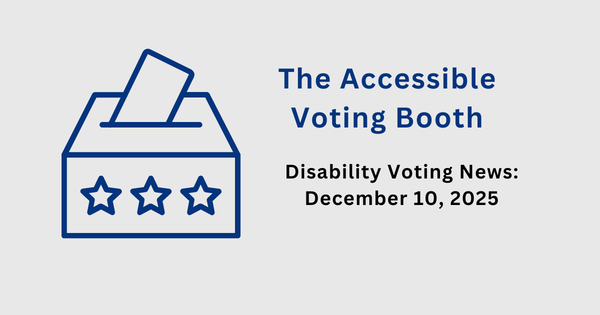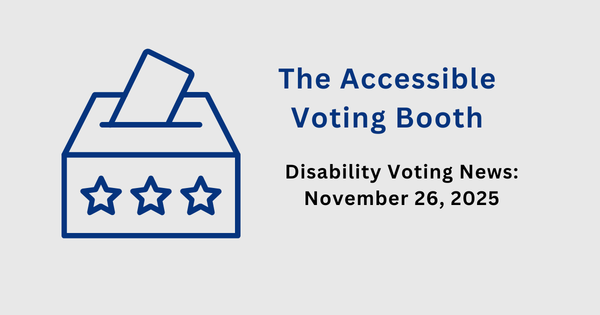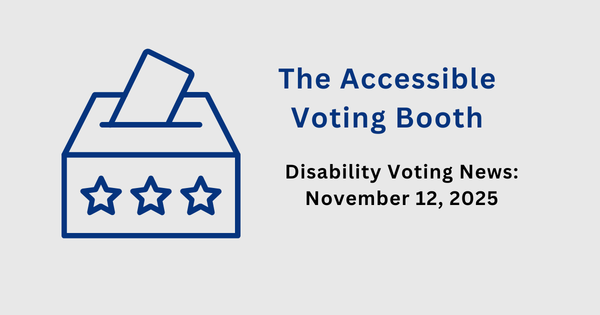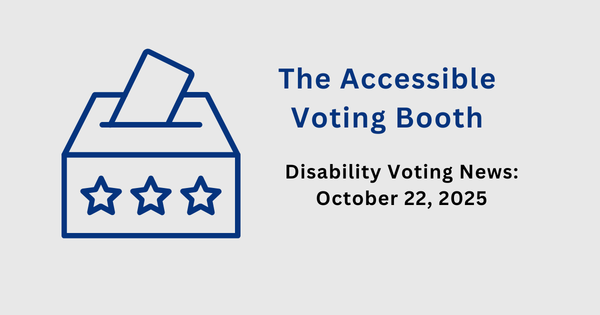Disability Voting News: May 7, 2025
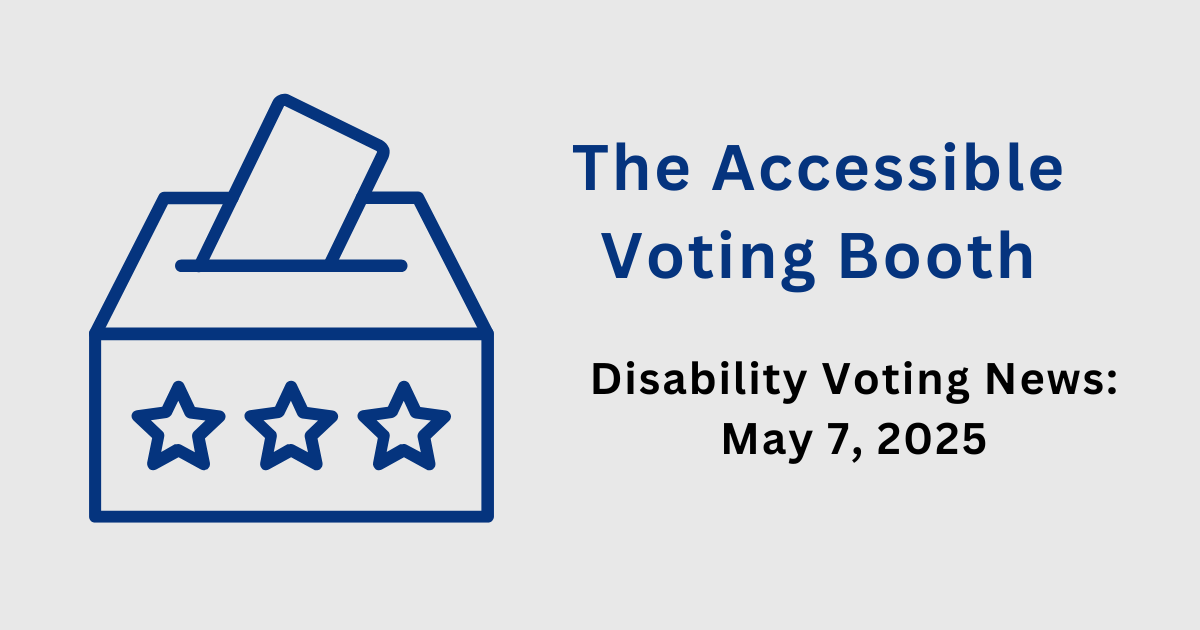
Welcome to The Accessible Voting Booth for May 7, 2025! This week, we’re going international with news and analysis on voting accessibility in Australia and Ireland. We’ll also be discussing legislation to ban vote centers and in-person early voting in Arizona, a bill in New York that will improve cognitive accessibility, and voting rights restoration in Tennessee.
“Voting with a disability can be a challenge, even in a country like Australia.” (via ABC News Australia)
Last week, ABC News Disability Affairs reporter Eleanor Beidatsch wrote a great piece on her experience with voting in Australia as someone with Spinal Muscular Atrophy. This piece showed that while the United States and Australia have some significant differences in their voting systems (such as the fact that voting is compulsory in Australia), they also share great similarity in terms of the ongoing barriers that people with disabilities face.
The Disability Discrimination Act (DDA) of 1992 is the main federal law that prohibits discrimination against people with disabilities in Australia. The Disability (Access to Premises - Buildings) Standards 2010 were created to establish standards for new buildings or existing buildings undergoing remodel. I didn’t have too much time to peruse them, but they seem similar to the ADA Standards for Accessible Design, laying out specific design requirements and guidelines. Like the Americans with Disabilities Act (ADA), the DDA creates a mechanism for people with disabilities to file discrimination complaints if their rights have been violated, including if they experience access barriers to buildings that should be accessible. Also like the ADA, organizations and businesses may defend themselves against a DDA complaint by proving that access would cause “unjustifiable hardship.”
In the piece, Beidatsch shares that her only early polling location is 50 kilometers from where she lives and isn’t wheelchair accessible–there was no way for wheelchair users to safely cross the street from parking and there were no ramps. This is similar to the United States, where polling places are plagued by access barriers outside of the building despite the fact that the Americans with Disabilities Act requires polling places to be accessible. Many of our polling places are in schools and government buildings which regularly fall under Title II of the ADA–meaning that they are regularly required to comply with the ADA even when not serving as polling places. However, one in five polling places are in churches that are exempt from the ADA–still, election officials are required to make temporary modifications to improving polling place accessibility. Unfortunately, the majority of polling places in the United States have access barriers outside of the polling place. In 2016, the U.S. Government Accountability Office examined the exterior of 178 polling places and found that 60% had one or more potential impediments.
Beidatsch reports that the Australian Election Commission had increased the number of accessible polling places for 2025 by 20% (I was unable to determine what the baseline prior to the 20% was to determine the scope of this increase). The AEC publishes accessibility ratings on whether polling places are wheelchair accessible–in the United States, polling places are not rated for accessibility, and it can be challenging to find information on the accessibility of individual polling places. In Australia, polling places are required to have two-person tables that accommodate a voter and their helper, accessible voting screens, hearing loops, and text-to-speech pens. Every polling place is also required to have a virtual Auslan (Australian Sign Language) interpreter–the United States has no such requirement for ASL interpreter access, although a few polling places around the country have been known to offer it.
Australia votes on paper ballots and does not offer ballot-marking devices, whereas in the United States, every polling place is required by the Help America Vote Act to have at least one ballot-marking device that provides nonvisual access to voters with disabilities and is accessible for voters with physical disabilities. In Australia, voters who are blind or have low vision may vote through a telephone voting service. If voters with disabilities cannot vote by hand marking a paper ballot independently or using the tools listed above, they can receive assistance from a poll worker or a person of their choice.
In terms of access outside of the polling place, Australia offers curbside voting for voters who are unable to leave the car or enter the polling place. They also offer postal voting for voters who have disabilities (as well as voters who are traveling, live far from a polling place, can’t leave work to vote, or for another qualifying reason). Voters must apply for postal voting, and ballots must be completed in front of and signed by a witness. Finally, the Australian Election Commission offers a mobile voting service where they visit certain locations to provide in-person voting access, including hospitals and residential care facilities, shelters, prisons, and First Nations locations. In the United States, curbside voting and vote by mail availability vary by state.
There is one other way that the United States and Australia are similar. In Australia, two sections of the Commonwealth Electoral Act disenfranchise people with cognitive disabilities from voting, creating a requirement that people with cognitive disabilities prove through medical evidence that they are “capable of understanding.” More than 28,000 people were removed from the voter roll between 2008 and 2012 in Australia due to these provisions. 75 Australian organizations and experts have formed a coalition to reform the law to ensure that people with disabilities have equal access to voting and Australia comes into compliance with the United Nations Convention on the Rights of Persons with Disabilities.
In the United States, many states disenfranchise people with cognitive disabilities or mental health conditions, and many states enact this through stripping the right to vote from people living under guardianship, with seven states stripping the right to vote from anyone under guardianship. People under guardianship continue to fight to regain their civil rights, but this is exceptionally difficult, even when they have the support of their guardian.
While the United States and Australia have very different voting systems, they share very similar barriers to access to voting for people with disabilities. Disability advocates in Australia and the United States share the commitment to breaking down these barriers to participation and ensuring that all people with disabilities can exercise their right to vote.
People with disabilities in Ireland are forced to pay for certificates to qualify for postal voting. (via Irish Examiner)
Disabled voters are calling attention to Ireland’s requirement that they have a doctor’s certificate to participate in postal voting. Under current law, voters with disabilities who want to participate in postal voting must obtain a certificate from a doctor saying that they are unable to vote in person at a polling place. The cost of that certificate is not covered by their health insurance. The piece notes that 23% of voters with a disability decided not to vote in the June 2024 elections due to their disability.
The Electoral Commission has called on the Irish government to remove the requirement, which serves as a significant barrier to electoral participation for people with disabilities.
Because this is a U.S.-based voting newsletter, I’m of course going to compare this to the situation in the United States: only one state, Louisiana, requires voters to provide documentation proving that they have a disability to vote by mail. This documentation can be a letter from a medical professional, mobility impaired identification card from the Office of Motor Vehicles, or documentation showing eligibility for disability benefits. Because the U.S. health insurance system is what it is, obtaining disability documentation from a doctor can be costly, and so this does pose a barrier to voting access. Many other states that offer absentee voting require voters to have a specific reason for using that option, such as disability or being away from home. However, they thankfully don’t require medical documentation (but I hope states hell bent on voter suppression don’t get any ideas). And of course, many states offer no-excuse absentee or mail-in voting, where any voter can vote by mail without having a specific reason to do so.
Requiring documentation of disability absolutely acts as a barrier to access. Some people may not be able to afford to go to the doctor or travel to a doctor’s office to get documentation. Some may not yet have diagnoses and may have difficulty just getting a doctor to take them seriously, let alone providing certification of a disability. Some may feel they aren’t “disabled enough” to use this accommodation even if it would greatly benefit them. And others may decide that it’s too time- and effort-consuming to obtain documentation just to be able to vote.
I hope that disabled Irish voters are successful in getting rid of this burdensome requirement and are able to participate in postal voting without having to prove that they are “disabled enough” to use postal voting.
Arizona bill to ban early voting locations and vote centers heads to governor’s desk. (via Voting Rights Lab)
Arizona HB 2017 has passed both chambers and is headed to the governor’s desk. This bill, if enacted, would eliminate in-person early voting, prohibit use of voting centers, and limit election precincts to contain no more than 1,000 registered voters at the time the location is designated. The Joint Legislative Budget Committee’s fiscal note on the bill calculated that it would require 3,957 new voting locations and over 27,000 poll workers to be added statewide to be able to meet the precinct size restriction, and it would cost $10.8 million for staff and site use and $31.5 million to obtain the voting equipment needed to operate those sites. This would also cause significant accessibility challenges, as election officials would have to vet new polling places for accessibility and train poll workers. In Maricopa County alone, election officials would need to add 2,457 new locations and 17,000 poll workers.
The bill would eliminate voting centers that are used in eight counties, as well as in five additional counties that use a hybrid system with precincts and voting centers. Voting centers differ from precinct-based voting in that they allow voters to go to vote at any vote center within the jurisdiction. In precinct-based voting, voters are assigned to a specific precinct and are only allowed to vote at that location. Vote centers provide greater flexibility to voters to vote at any polling place in their jurisdiction, and they are particularly beneficial for voters in rural areas and minority communities.
Finally, this bill would also ban in-person early voting. Currently, any registered voter may participate in in-person early voting, which begins 27 days before the election and ends the Friday before the election. Eliminating in-person early voting would increase lines at the polling place on Election Day, which is particularly interesting because the author of HB 2017, Rep. Rachel Keshel (R), cited long lines at early voting centers as a reason for eliminating them through this bill (when counties use a voting center model, they frequently have fewer polling places than they would if they utilized precinct-based voting).
To eliminate in-person early voting greatly reduces voters’ flexibility and options for voting. While voters would still have the option of no-excuse voting by mail, voters have many reasons that they may prefer to vote in person. In Arizona, there is no option to receive and mark a ballot electronically for voters with print disabilities, so voters who are blind, have low vision, or have a physical disability that impacts their ability to hand mark their ballot would have to go to a polling place or vote center to use a ballot-marking device to read and mark their ballot independently. If Arizona eliminates in-person early voting, voters who want to vote at a polling place would only be able to do so on Election Day.
HB 2017 now heads to the desk of Governor Katie Hobbs (D), who will hopefully veto the legislation.
New York Bill introduced to educate voters about closed primary system. (via Voting Rights Lab)
New York AB 8126 was introduced on May 1 to accomplish a simple goal: to inform New York voters about the state’s closed primary system. The bill would require voter registration forms to say in bold and prominent type: “The state of New York practices a closed primary system. Political party enrollment is optional, but, in order to vote in a primary election of a political party, a voter must enroll in that political party, unless state party rules allow otherwise.”
This is a simple but important change because it educates voters on what closed primaries are and what they must do to participate in them. This increases the cognitive accessibility of voting. As someone who works in voting rights, it can be very easy to forget that voters don’t spend nearly as much time as I do thinking about or learning about elections, and so they aren’t as familiar with the ways elections operate and their options for participating in voting. Additionally, 54% of American adults read below the equivalent of a sixth grade level. That’s why we need more plain language, which defines unfamiliar terms and shares information in clear, simple ways. Election rules and laws can be very confusing, and plain language clarifies those rules so that voters can easily understand procedures and requirements. AB 8126 is a simple and effective way to inform voters about the voting process so that they can make an informed decision on whether to register for a political party and vote in primaries.
Tennessee enacts voting rights restoration legislation. (via Voting Rights Lab)
Tennessee Governor Bill Lee (R) signed SB 407 into law, changing the process for restoring voting rights for people with felony convictions in Tennessee. Prior to signing this law, the state Supreme Court ruled in 2023 that people convicted of a felony had to get their gun rights restored before they could become eligible to restore their right to vote. In Tennessee, someone’s “full citizenship rights” must be restored before they can regain their right to vote, and under the Tennessee Constitution, “the right to bear arms is a right of citizenship.”
AP News did a great rundown on how Tennessee’s law worked prior to this legislation–it noted that the processes both before and after the 2023 ruling were very complicated, making it difficult for returning citizens to regain their voting rights. Now that SB 407 is enacted, returning citizens can ask a judge to restore their right to vote without having to restore their gun rights. They’ll still need to meet certain requirements, including proving their eligibility, as well as proving they are up to date on child support and court cost requirements.
AP News also notes that while this change is positive, voting rights advocates feel that the bill doesn’t go far enough, and that’s certainly true. Returning citizens will still have to pay fees, submit to signed statements, and provide significant evidence of their eligibility. Meanwhile, people with felony convictions never lose their right to vote in Washington, DC and two states; only lose their rights while incarcerated and experience automatic restoration in 23 states; and lose their rights during incarceration and for a period of time after (usually during probation or parole) and experience automatic restoration after the completion of their full sentence in 15 states.
Keep in mind that voting rights restoration is absolutely a disability issue. Disabled people are overrepresented in the criminal justice system: 40% of people in state prisons have a disability (compared to being 15% of the population), and 25% of incarcerated people have cognitive disabilities.
Reminder: Register for the National Voting Access Summit: Building a Democracy for All
Join the National Polling Access Audit Coalition for a critical two-day summit about making voting more accessible for all. The National Voting Access Summit will bring together advocates, researchers, policy makers, and voting rights experts to discuss solutions to the challenges the disability community is experiencing in regards to voting access.
The summit will take place virtually on Zoom on Monday, May 19 and Tuesday, May 20 from 12-4 PM Eastern. American Sign Language interpretation and CART captioning will be provided. Register for the National Voting Access Summit.
Thank you for reading this week’s edition of The Accessible Voting Booth! I’ll be back next week with more updates. As always, if you’d like to support the newsletter and my work, here’s how:
- Subscribe to the Accessible Voting Booth newsletter.
- Hire me! If you or someone you know is looking to hire a disability civic engagement expert, please reach out. I’m also available for communications and administrative work through my LLC, Landmark Virtual Assistance.
- Leave me a tip. Thank you for supporting my work!

